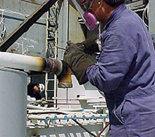Asbestos
Exposure to asbestos can be a serious health risk if asbestos-containing material is disturbed in such a way that the particles and fibers become airborne. Symptoms of asbestos-related diseases, such as shortness of breath, coughing, and chest pain, often do not appear until 20 to 50 years after the exposure.
If you are concerned about health problems associated with asbestos exposure during your military service, talk to your health care provider or contact your local VA Environmental Health Coordinator to help you get more information from a health care provider.
How Veterans may have been exposed to asbestos

Pipefitter
Veterans who served in any of the following occupations may have been exposed to asbestos: mining, milling, shipyard work, insulation work, demolition of old buildings, carpentry and construction, manufacturing and installation of products such as flooring and roofing.
Veterans who served in Iraq and other countries in that region could have been exposed to asbestos when older buildings were damaged and the contaminant released into the air.
Health problems associated with exposure to asbestos
Breathing asbestos mainly causes problems in the lungs and the membrane that surrounds the lungs, including:
- Asbestosis: Scarring of lung tissue that causes breathing problems, usually in workers exposed to asbestos in workplaces before the Federal government began regulating asbestos use (mid-1970s).
- Pleural plaques: Scarring in the inner surface of the ribcage and area surrounding the lungs that can cause breathing problems, though usually not as serious as asbestosis. People living in areas with high environmental levels of asbestos, as well as workers, can develop pleural plaques.
- Cancer: The two types of cancer caused by exposure to asbestos are lung cancer and mesothelioma, a cancer of the thin lining surrounding the lung (pleural membrane) or abdominal cavity (the peritoneum). Mesothelioma is a rare form of cancer usually caused by asbestos exposure.
Learn more about asbestos and its health effects from the Agency for Toxic Substances and Disease Registry.
Health concerns?
If you are concerned about health problems associated with exposure to asbestos during your military service, talk to your health care provider or contact your local VA Environmental Health Coordinator to help you get more information from a health care provider.
VA offers a variety of health care benefits to eligible Veterans. Not enrolled in the VA health care system? Find out if you qualify for VA health care.
Compensation benefits for health problems
Veterans may file a claim for disability compensation for health problems they believe are related to exposure to asbestos during military service. VA decides these claims on a case-by-case basis. File a claim online.
Learn more about VA benefits.




















